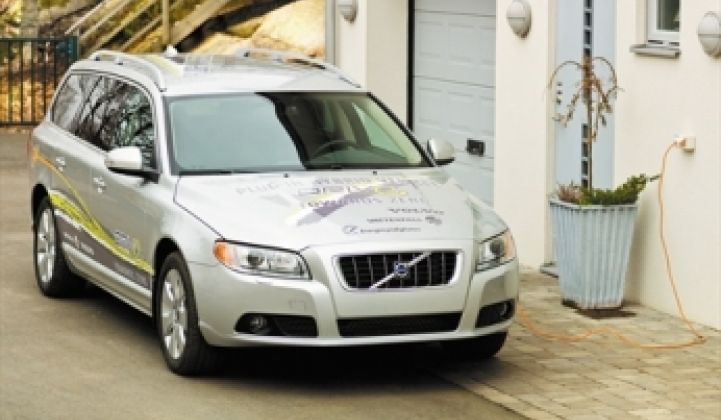In early 2007 Volvo and Swedish power company Vattenfall set out to test and develop plug-in technology aimed at series-producing plug-in hybrid cars in Sweden. Today they announced the result from their joint project: In three years you will be able to drive an electric and diesel hybrid Volvo.
Volvo will manufacture the new hybrid cars while Vattenfall will develop the charging system and supply the cars with electric power. The plug-in hybrid will be more expensive than a conventional Volvo V70, but according to Volvo, the fuel costs will be cut by one third compared to a regular diesel engine car. Vattenfall will also deliver power to the cars from renewable electricity sourced specifially from windpower or hydropower.
"The engine will also be prepared for running on syntetchic bio-diesel. The emissions are below 50 grams per kilometer, its a 50 percent reduction compared to the best hybrids on the market today. Running cost will be a third of a conventional car today," said Stephen Odell, CEO of Volvo Cars, when presenting the new car in downtown Stockholm, Sweden.
"Through electric power, we avoid the emissions from each individual car. Instead of petrol or diesel, the energy is derived from a few large power sources and Vattenfall is working hard to eliminate carbon dioxide emissions from all electricity production. In Sweden, virtually all Vattenfall's electricity production is emission-free," said Lars G Josefsson, President and CEO of Vattenfall, in a statement.
The new electric Volvo engine will deliver 11.3 kilowatts or 100 horsepower. The technology can be adapted to any other fuels or engine combinations. According to Volvo, the lithium-ion battery in the new hybrid will charge in five hours on a regular wall socket, and it also uses breaking power to charge. However, there are diffrences to competitors like the Toyota Prius.
"We're skipping one step of the hybrid evolution – not using a small battery that charges from the combustion engine and brake power all the time. Instead, we use a big battery, which you recharge at home during night time and will reach 30 miles on one charge. Then, the combustion engine will start powering the car, said Paul Gustavsson, Manager for the joint hybrid project at Volvo, to Swedish daily technology paper Ny Teknik.
During the summer of 2009, three demonstration cars will be evaluated. Vattenfall is testing different concepts for high-speed home charging and charging stations in public places.
Questions were made about what happened to the previous hybrid attempt from Volvo, the "C30 Recharge." According to Stephen Odell, that project informed the development of the new hybrid.
To succeed, Volvo and Vattenfall want government support. Stephen Odell claimed that since the new car is below 50 grams emission per kilometer, it is valid for tax credits when put on market.
"We are going to need some sort of incentives. The English and Swedish government have indicated that they're willing to support these type of cars," he said.



